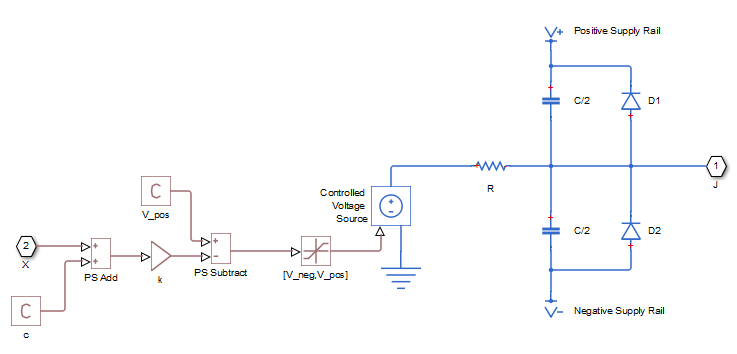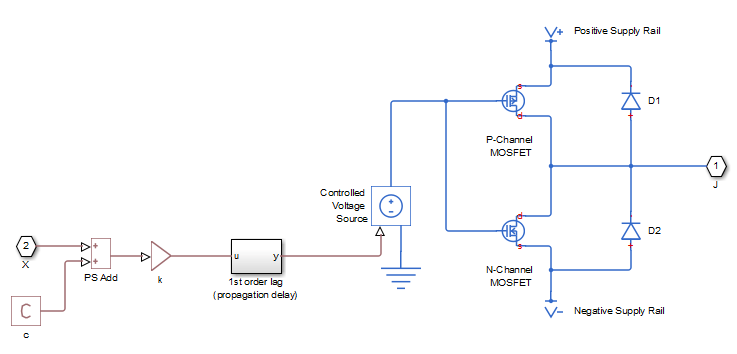Push-Pull Output
Behavioral representation of CMOS complementary output stage
Libraries:
Simscape /
Electrical /
Integrated Circuits
Description
The Push-Pull Output block represents a CMOS complementary output stage behaviorally. To improve simulation speed, the block does not model all the internal individual MOSFET devices that make up the gate. You can use this block to create a representative output current-voltage relationship when defining an integrated circuit model behavior with Physical Signal blocks from the Simscape™ Foundation library.
You can choose between are two output current-voltage relationships:
Linear— The block represents the output as a voltage source plus series resistance and parallel capacitance, as shown in the following figure. The value you specify for the Output resistance parameter is assigned to the series resistance, and the capacitance values are determined by matching the RC time constant to the Propagation delay parameter value.
The input to the Controlled Voltage Source block is limited to be between the supply rails, and it is also inverted by subtraction from the supply voltage. The inversion makes it behave like a complementary output stage, with a high gate-source voltage resulting in a low output.
Quadratic— The output stage is modeled by the two MOSFETs that constitute the complementary pair. The MOSFET parameters are derived from the output resistance values and short-circuit currents that you specify as mask parameters. The gate input demand is lagged to approximate the Propagation delay parameter value.
Both Linear and Quadratic output
models add an offset and scale the physical input X so that the gate voltage is given
by:
| Vg = k · ( X + c ) | (1) |
where
k is the input signal scaling.
c is the input signal offset.
The offset and scaling can be used, for example, to match logical values for X (that
is, range [0,1] ) to [V-, V+] at the output pin. For example, if V+ =
10V and V- = 0, then to match the signal logical values to this voltage range, set
c = -1 and k =
-10.
For both Linear and Quadratic
output models, the protection diodes D1 and D2 act to limit the output voltage range.
These diodes are Diode blocks from the Simscape Foundation library, that is, piecewise linear diodes defined by their
forward voltage and on resistance. If the voltage across D1 rises above the forward
voltage, then the diode starts to conduct, and provided that the on resistance is low,
it effectively prevents the output rising above V+ plus the diode forward voltage drop.
An equivalent behavior results if the output voltage drops too low.
The output model is very similar to that used for the logic blocks. For a plot of a
typical output V-I characteristic when using the Quadratic
output model, see Selecting the Output Model for Logic Blocks.
Note
This block is constructed out of blocks from the Simscape Physical Signals library (such as PS Add, PS Gain, and so on). Currently, the blocks in the Physical Signals library do not support unit propagation and checking. For more information, see How to Work with Physical Units.
Examples
Assumptions and Limitations
The block does not accurately model dynamic response.
The
Quadraticoutput model does not model any output capacitance effects. Add output capacitance externally to the block if required.
Ports
Input
Conserving
Parameters
Extended Capabilities
Version History
Introduced in R2011b

